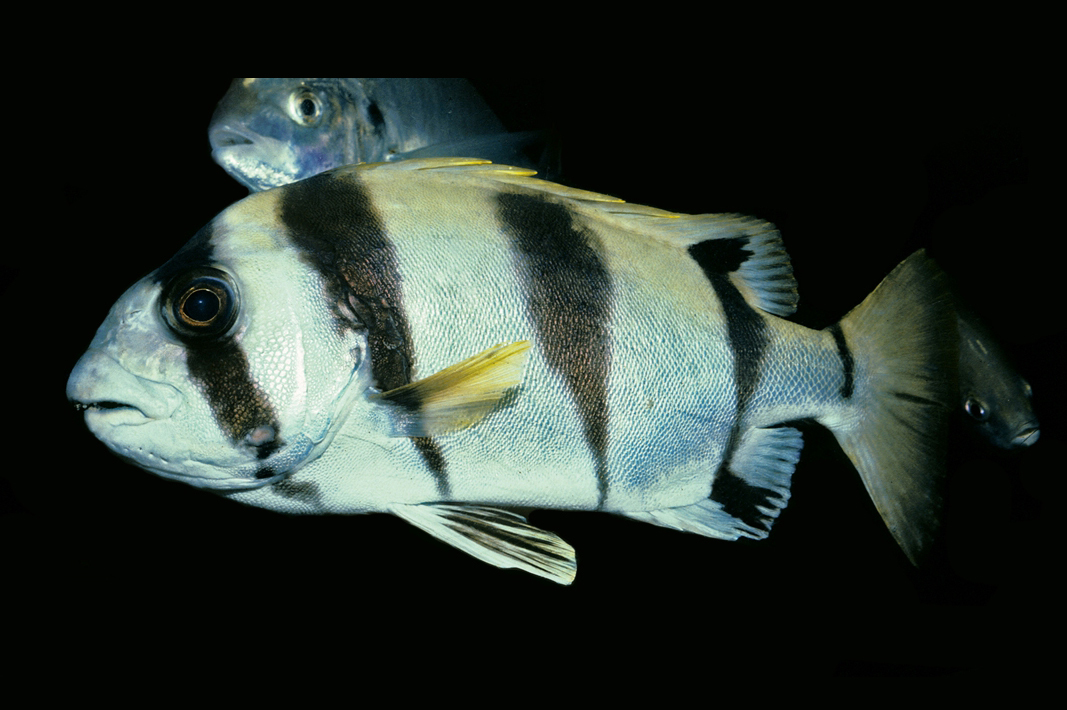Knifejaw, Oplegnathus woodwardi (Waite 1900)

A Knifejaw, Oplegnathus woodwardi. Source: Rudie H. Kuiter / Aquatic Photographics. License: All rights reserved
The Knifejaw is a deep-bodied fish with teeth fused into a parrot-like beak, a long-based dorsal fin and five broad dark vertical bands on the head and body.
Knifejaw, Oplegnathus woodwardi (Waite 1900)
More Info
|
Distribution |
Endemic to temperate waters of southern Australian waters, from about Terrigal (New South Wales) to Cape Cuvier (Western Australia), and around Tasmania. The Knifejaw is mainly taken in trawls in offshore waters in depths of 50-400 metres. The species is particularly common in the Great Australian Bight. Juveniles are occasionally found in inshore shallows. |
|
Features |
Dorsal fin XI, 11; Anal fin III, 10–11; Pectoral fin 17; Pelvic fin I, 5; Caudal fin 17; Lateral line scales, ~ 62; Gill rakers (lower limb) 12. Body deep, of moderate length, very compressed; caudal peduncle moderately shallow; head moderately large; eyes large; mouth small; teeth in jaws of adults fused to form sharp beak-like cutting edges, each jaw with a median division. Dorsal fin long-based, continuous, originating behind head, spinous portion with a longer base than soft-rayed portion; dorsal-fin spines strong, compressed, spines and soft‑rays of similar length, with the longest spines slightly longer than longest rays; anal fin similar and opposite posterior half to thirds of dorsal fin, spines strong; caudal fin emarginate; pectoral fins of moderate size, upper rays longest, upper corner of fin pointed; pelvic fins thoracic, originating below pectoral-fin bases, each with a very strong spine. Scales finely ctenoid, small, covering body and head; lateral line curved, following dorsal profile of body. |
|
Size |
To 48 cm. |
|
Colour |
Brown to yellowish-grey above, yellow or cream below, with 5 broad black vertical bands on side, the first passing through the eye, the fifth crossing the caudal peduncle; fins tinged with yellow, black blotch on soft part of dorsal and anal fins. |
|
Feeding |
Carnivore - the beak-like jaws are well adapted for crushing hard shelled invertebrates. |
|
Biology |
Little is known of the biology of this species. |
|
Fisheries |
The Knifejaw is most frequently taken in commercial trawls and is regarded as an excellent food fish. |
|
Conservation |
|
|
Species Citation |
Hoplegnathus woodwardi Waite 1900, Rec. Aust. Mus. 3(7): 212. Type locality: Swan River, WA. |
|
Author |
Bray, D.J. 2017 |
|
Resources |
Knifejaw, Oplegnathus woodwardi (Waite 1900)
References
Coleman, N. 1980. Australian Sea Fishes South of 30ºS. Lane Cove, NSW : Doubleday Australia Pty Ltd 309 pp.
Glover, C.J.M. 1994. Family Oplegnathidae. pp. 637-638, fig. 560 in Gomon, M.F., Glover, C.J.M. & Kuiter, R.H. (eds) The Fishes of Australia's South Coast. Adelaide : State Printer 992 pp. 810 figs.
Gomon, M.F. 2008. Families Oplegnathidae and Chironemidae. pp. 619-622 in Gomon, M.F., Bray, D.J. & Kuiter, R.H. (eds) Fishes of Australia's Southern Coast. Sydney : Reed New Holland 928 pp.
Hutchins, J.B. & Swainston, R. 1986. Sea Fishes of Southern Australia. Complete field guide for anglers and divers. Perth : Swainston Publishing 180 pp.
Hutchins, J.B. & Thompson, M. 1983. The Marine and Estuarine Fishes of South-western Australia. Perth : Western Australian Museum 103 pp. 345 figs.
Last, P.R., Scott, E.O.G. & Talbot, F.H. 1983. Fishes of Tasmania. Hobart : Tasmanian Fisheries Development Authority 563 pp. figs.
May, J.L. & Maxwell, J.G.H. 1986. Field Guide to Trawl Fish from Temperate Waters of Australia. Hobart : CSIRO Division of Marine Research 492 pp.
Regan, C.T. 1916. Fishes from Natal, collected by Mr. Romer Robinson. Annals of the Durban Museum 1(3): 167-170 (as Hoplegnathus australis)
Scott, T.D., Glover, C.J.M. & Southcott, R.V. 1974. The Marine and Freshwater Fishes of South Australia. Adelaide : Government Printer 392 pp. figs. (misidentified as Ostorhinchus conwaii)
Waite, E.R. 1900. Notes on fishes from Western Australia, and description of a new species. Records of the Australian Museum 3(7): 210-216 fig. 37
Yearsley, G.K., Last, P.R. & Ward, R.D. (eds) 1999. Australian Seafood Handbook. Hobart : CSIRO Marine Research 460 pp.
Heemstra, P.C. 2010. Oplegnathus woodwardi. The IUCN Red List of Threatened Species 2010: e.T154661A4600136. http://dx.doi.org/10.2305/IUCN.UK.2010-4.RLTS.T154661A4600136.en. Downloaded on 13 February 2017.





